Ed Gorman's Blog, page 122
July 22, 2013
PAPERBACK CONFIDENTIAL FROM THE GREAT STARK HOUSE
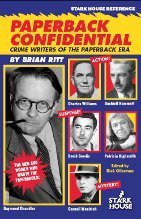
Ed here: I wanted this book to be fourteen hundred pages long. I'm just hoping there are numerous other volumes to come because this is some of the finest non-fiction about the history of hardboiled fiction ever published. Every page contains a gem. Order this immediately and make sure to insist that the Pope makes Brian Ritt a saint right now!
Brian Ritt has written about vintage paperbacks for Paperback Parade, The Paperback Fanatic, and contributed an introduction to Stark House's Orrie Hitt omnibus.
$19.95 Paperback Confidential978-1-933586-61-8128 profiles of the men and women who wrote the books that became the backbone of the Pulp and Paperback Era from the 1930s through the 1960s. Here you will find information on the acknowledged masters like Dashiell Hammett, Raymond Chandler, James M. Cain and Cornell Woolrich... the rack mainstays like Gil Brewer, Brett Halliday, Day Keene, and Charles Williams... and the unjustly forgotten like Malcolm Braly, Elisabeth Sanxay Holding, Ennis Willie and Douglas Sanderson. Schedu
Published on July 22, 2013 14:50
A new book about Sam PeckinpahWEDNESDAY, MAY 05, 20...
[image error]
A new book about Sam Peckinpah
WEDNESDAY, MAY 05, 2010
Over on Cinema Retro the estimable Lee Pfeiffer discusses a new book about Sam Peckinpah:
"Entered His House Justified: The Making of the Films of Sam Peckinpah" may have one of the longest titles of the year, but anything relating to the master maverick director is difficult to summarize. The latest in a line of shelf-breaking volumes dedicated to Peckinpah is from author Jeff Slater, who has amassed an impressive list of interviewees to shed new light on one of the film industry's most analyzed personalities. Peckinpah, like so many other geniuses, was not completely appreciated in his own time, partly due to the inability of studio executives to recognize his innovative filmmaking techniques and partly because Peckinpah- like Orson Welles- specialized in forming circular firing squads. His own excesses often did more damage than did the legendary studio interference with the classic movies he produced.
"Slater's book is niche market in the best sense of the word. As an author, he has gone the self-publishing route through Booksurge. As such, he has not had to make the kind of literary compromises his subject had to in order to pacify the corporate "suits". The book features insights from Peckinpah scholars and associates, but what really justifies the book's hefty $72.95 price tag is the abundance of stunning photos, many of which will be rare to even the most fervent Peckinpah collector. Particularly impressive are some wonderful candid photos taken of Peckinpah behind the scenes on some of his most famous films. Peckinpah was the ultimate independent movie maker trapped in an era in which one had to play ball with the studio moguls in order to get financing for his films. Thus, some of his more personal works were cut without his consent and watered down in the process (i.e Major Dundee, The Wild Bunch and Pat Garrett and Billy the Kid.)"
for the rest go here: http://www.cinemaretro.com/index.php
Ed here: I feel sorrier for Peckinpah than I do Welles. Too often Welles seemed to be a jerk just because he felt he was entitled to by rights of his genius. I've mentioned before an audio tape of Welles cutting a voice over for the wine company he represented in the 70s or 80s. I've been in dozens of such sessions myself. The people from the ad agency, the talent and the engineers want to get the best results in the easiest way. It's generally a pleasant atmosphere (though as the great Herschel Bernardi showed in his famous spoof tape about cutting a spot, sometimes it gets insane--"Could you goose the word `Good" a little more? The client is trying to copyright `good?'") but not with Welles involved. He breaks out with one of the most abusive and extended spoiled brat rages I've ever heard. He singles out the agency boys and rubs their faces in his opinion of their copy and their suggestions for reading it. He makes it very personal and he makes them grovel. This is a guy whose ship had sailed long ago and who should be grateful that he's making big bucks for very little work--I mean, c'mon, voice overs anin't exactly like working in coal mines. Or anywhere near as dangerous.
Peckinpah on the other hand was a stubborn drink, true, but unlike Welles he did his work despite the odds. They cut his pictures but he went on anyway. He was a prick on the set and a prick in meetings with the suits but that never deterred him from realizing his vision. Welles fans always talk about how the Magnificent Ambersons was cut by Robert Wise at the studio's request and direction. Well, maybe if Welles had stuck around for the editing in the first place (I mean, he was the director after all) he might have been able to buck the studio. But he was off on another (failed, as I recall) project. I don't mean to demean Welles. Citzien Kane is one of the two or three finest films ever made. No doubt about it. And I love several of his movies. And I don't doubt he was forced to work with idiots. But this myth about him as this suffering genius...no matter how brilliant you are you have to stay focused and do your work. And you have to somehow make deals with the devil as Peckinpah somehow did in his sad and ragged career.
A new book about Sam Peckinpah
WEDNESDAY, MAY 05, 2010
Over on Cinema Retro the estimable Lee Pfeiffer discusses a new book about Sam Peckinpah:
"Entered His House Justified: The Making of the Films of Sam Peckinpah" may have one of the longest titles of the year, but anything relating to the master maverick director is difficult to summarize. The latest in a line of shelf-breaking volumes dedicated to Peckinpah is from author Jeff Slater, who has amassed an impressive list of interviewees to shed new light on one of the film industry's most analyzed personalities. Peckinpah, like so many other geniuses, was not completely appreciated in his own time, partly due to the inability of studio executives to recognize his innovative filmmaking techniques and partly because Peckinpah- like Orson Welles- specialized in forming circular firing squads. His own excesses often did more damage than did the legendary studio interference with the classic movies he produced.
"Slater's book is niche market in the best sense of the word. As an author, he has gone the self-publishing route through Booksurge. As such, he has not had to make the kind of literary compromises his subject had to in order to pacify the corporate "suits". The book features insights from Peckinpah scholars and associates, but what really justifies the book's hefty $72.95 price tag is the abundance of stunning photos, many of which will be rare to even the most fervent Peckinpah collector. Particularly impressive are some wonderful candid photos taken of Peckinpah behind the scenes on some of his most famous films. Peckinpah was the ultimate independent movie maker trapped in an era in which one had to play ball with the studio moguls in order to get financing for his films. Thus, some of his more personal works were cut without his consent and watered down in the process (i.e Major Dundee, The Wild Bunch and Pat Garrett and Billy the Kid.)"
for the rest go here: http://www.cinemaretro.com/index.php
Ed here: I feel sorrier for Peckinpah than I do Welles. Too often Welles seemed to be a jerk just because he felt he was entitled to by rights of his genius. I've mentioned before an audio tape of Welles cutting a voice over for the wine company he represented in the 70s or 80s. I've been in dozens of such sessions myself. The people from the ad agency, the talent and the engineers want to get the best results in the easiest way. It's generally a pleasant atmosphere (though as the great Herschel Bernardi showed in his famous spoof tape about cutting a spot, sometimes it gets insane--"Could you goose the word `Good" a little more? The client is trying to copyright `good?'") but not with Welles involved. He breaks out with one of the most abusive and extended spoiled brat rages I've ever heard. He singles out the agency boys and rubs their faces in his opinion of their copy and their suggestions for reading it. He makes it very personal and he makes them grovel. This is a guy whose ship had sailed long ago and who should be grateful that he's making big bucks for very little work--I mean, c'mon, voice overs anin't exactly like working in coal mines. Or anywhere near as dangerous.
Peckinpah on the other hand was a stubborn drink, true, but unlike Welles he did his work despite the odds. They cut his pictures but he went on anyway. He was a prick on the set and a prick in meetings with the suits but that never deterred him from realizing his vision. Welles fans always talk about how the Magnificent Ambersons was cut by Robert Wise at the studio's request and direction. Well, maybe if Welles had stuck around for the editing in the first place (I mean, he was the director after all) he might have been able to buck the studio. But he was off on another (failed, as I recall) project. I don't mean to demean Welles. Citzien Kane is one of the two or three finest films ever made. No doubt about it. And I love several of his movies. And I don't doubt he was forced to work with idiots. But this myth about him as this suffering genius...no matter how brilliant you are you have to stay focused and do your work. And you have to somehow make deals with the devil as Peckinpah somehow did in his sad and ragged career.
Published on July 22, 2013 11:17
July 21, 2013
NEW BOOKS: SLAMMIN' by FRED BLOSSER
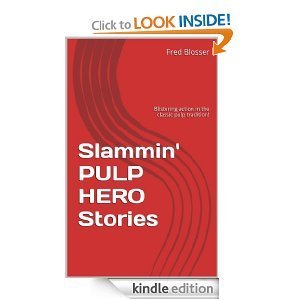
NEW BOOKS: SLAMMIN' PULP HERO STORIES by Fred Blosser KINDLE $2.99
The seven tales in SLAMMIN’ PULP HERO STORIES cover a range of settings and characters. In all of them, I wanted to replicate the energy of old-style pulp adventure, stripped down to the basic formula of the modern action film: Keep things moving and keep it noisy. Did I succeed? I’ll leave the final judgment to the reader.
“Gunpoint,” in a slightly different form, first appeared in BEAT TO A PULP. The setting is a West Virginia coal camp in the early 1900s, where fact and fiction converge. Five characters are based on historical figures, and there really was a saloon war involving two sons of the feuding Hatfield family. The two lead characters, gunslingers-for-hire Ringo & Horn, are fictitious. In “Bulletpoint,” the grandsons of Ringo & Horn operate in modern-day West Virginia, in the area where I grew up along the Kanawha Valley. I have to give credit to my friend Bill Davis, who pointed me in this direction years ago; any sins of execution are mine.
“Trail of the Curly Wolf” and “Skirmish at Cattail Creek” feature the Tomahawk Men, the frontier traders who extended the westernmost borders of English America in 1710. I had in mind Louis L’Amour’s historical Western adventures of the early Sackett and Chantry families. These two short tales, which perhaps more properly should be called vignettes, originally appeared in somewhat different form in OWLHOOT, the quarterly APA-zine of the Old West Literary Heritage Organization of Old Timers, ramrodded by Cap’n Bob Napier. I have a novel about the Tomahawk Men in the wings.
“The City of Nightmare Fear,” featuring a masked vigilante, Commander Manta, and “Hero’s Helper,” with G-Man Gila, are patterned on 1930s hero pulp. “The Night of Satan’s Murder Syndicate” unites the modern-day Ringo & Horn and the descendants of the Tomahawk Men, Manta, and Gila to foil a terrorist plot. My model here was Jack Higgins with a touch of old-school pulp and the Transporter.
I hadn’t seriously considered self-publishing until my friend John Whalen ventured into Amazon’s CreateSpace to publish his novella SAMURAI BLADE, one of a series of Weird Westerns featuring his monster-hunter character Mordecai Slate. When John did that, I started thinking: I’ve got these stories sitting in my computer, collecting dust or whatever you collect inside a Mac hard drive. Why not throw ‘em out on Kindle and see if anyone is interested. The book concludes with three short articles about Lester Dent, John D. MacDonald, and Dashiell Hammett, preserving material that I’d previously published in small-circulation journals in somewhat different form years ago.
By the time I started reading genre fiction as a kid in the early 1960s, the real pulp era had ended. Nevertheless, the spinning racks of paperbacks in every drug store, newsstand, and bus station were filled with titles that either reprinted classic pulp fiction or updated the formula for a modern generation of (mostly male) readers. Today, to find this style of stripped-down, bullet-fast fiction, you mostly have to go to e-books and POD publishers. I hope readers like SLAMMIN‘ PULP HERO STORIES.
Published on July 21, 2013 12:25
July 20, 2013
From the great Ken Levine My favorite schocky movie
My favorite schocky movie
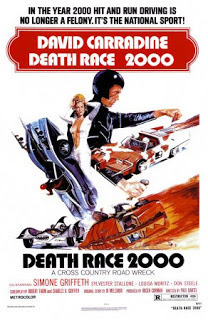
Ed here: I love this movie, too. I've seen it numerous times and it's always great for an affectionate laugh. Roger Corman was born to make this one.
Ken Levine:
A number of you have asked what is my favorite schlocky movie? That would have to be the Roger Corman 1975 masterpiece, DEATH RACE 2000. It's your typical low budget exploitation science fictionapocalyptic violent cross country auto race romp. The tagline:
IN THE YEAR 2000 HIT AND RUN DRIVING IS NO LONGER A FELONY. IT'S A NATIONAL SPORT!
I have to love a movie where the Real Don Steele's name is on the one-sheet but Sylvester Stallone's is not. (The above poster hangs in my office.)
The delightful confection of a story is that there is a cross country race in modified Batmobiles and the drivers get additional points for running down pedestrians. (Hey, don't laugh. It's still a better premise than GROWN UPS 2.)
Here is a sample.
Warning: Not for the squeamish -- and by that I mean anyone who can't bear to watch really bad cheesy special effects.
http://kenlevine.blogspot.com/2013/07...
Published on July 20, 2013 14:30
July 19, 2013
Ross Thomas, The Procane Chronicle
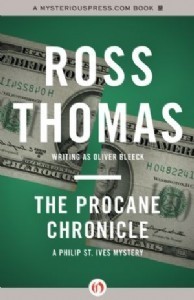
Ross Thomas, The Procane Chronicle
One of life’s true pleasures is reading a Ross Thomas novel. He never lets you down when you re-read him, either.
I’ve now read The Procane Chronicle for the third or fourth time, and even though I now know all the amazing surprises Thomas blesses his readers with, the prose alone is as much fun as the story. The only writer living today who can even come close to the grace and nimbleness of Thomas is Lawrence Block. Block knows from sentences.
In this one, Phillip St. Ives is dragooned by poverty as usual to act as a go-between when a blackmailer sets a price. St. Ives is hired to make sure that both sides keep their promise. The stake this time is a possible Mafia war.
As always, Thomas gives us a radiantly cynical take on Washington, D. C. and all who do business there. Though thirty years have past since original publication, Procane depicts a nation’s capitol no different from the one we know today. St. Ives is lied to and betrayed by everything on two legs, even – or especially – those fine looking female legs.
For me, Thomas was one of the two or three best crime writers of the last century. He brought to each book a witty and brutal intelligence that exposed all of us as less than we’d want to be.
http://mysteriouspress.com/products/e... Get it at Mysterious Press on line books or try ABE etc.
——
Published on July 19, 2013 13:06
July 18, 2013
Forgotten Books: THE HIDDEN by Bill Pronzini
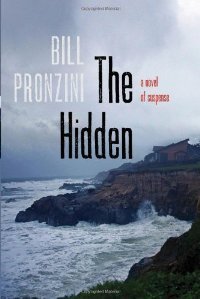 Forgotten Books: THE HIDDEN by Bill Pronzini
Forgotten Books: THE HIDDEN by Bill PronziniI know, I know, since this was published not long ago, it's hardly forgotten. But it is one of those books that deserved much more promotion and notice than it received. Bill Pronzini the master of mixing shattered lives and violence and The Hidden is almost claustrophobic in its shadowy Woolrichian power.
Bill Pronzini is not only a Grand Master of the Mystery Writers of America, he's a Grand Master of the dark and sinister noir novel. He demonstrates this again in one of his finest (perhaps the finest) books in his long career.
Jay Macklin is a failed man. A career as a baseball player was ended early by injury. As were other attempts at establishing himself. His decade-plus marriage to Shelby was so solid and good for a long time but unemployment and heart trouble (the latter something she doesn't know about) have taken their toll. Shelby finds herself attracted to a doctor at the hospital where she works as a paramedic.
The novel brings Jay and Shelby together in an anxious attempt to find their old love and respect. They travel to a cottage in rugged Northern California only to meet Brian and Claire Lomax, a married couple who has even more problems than they do. They also become aware of a serial killer who has been traveling this same area. A power failure seems symbolic of their marriage's final days.
Pronzini has always been at his best dealing with smashed lives. HIs descriptions of violent weather and pitiless nature only enhance the emotional turbulence that make the drama so rich. Gripping, sinister, unpredictable, The Hidden is a sinewy novel of treachery and terror by a true master of the form.
Published on July 18, 2013 18:50
July 17, 2013
New Books UNSPEAKABLE by Kevin O' Brien

[image error]
For seventeen years, before his thrillers landed him on The New YorkKevin O'Brien has produced six more best-selling thrillers--published in a dozen
Times Bestseller list, Kevin O'Brien made his living as a railroad
inspector and did all his writing at night. His second novel, ONLY SON
(1996), was optioned for film rights, thanks to interest from David
Seltzer (THE OMEN)and Tom Hanks. It was also chosen by Readers Digest
for its Select Editions--along with John Grisham's THE PARTNER. "Seeing
my photo on the back cover--alongside John Grisham--really made me feel
as if I'd 'arrived' as an author," Kevin admits.
Kevin has been writing full time ever since. But he hasn't forgotten
his railroad "ties." So--if on occassion, you find a scene in a Kevin
O'Brien thriller in which a dead body is discovered in a railroad yard,
well, now you know why.
THE NEXT TO DIE (2001), his first thriller, was a USA Today Bestseller.
More bestsellers followed with MAKE THEM CRY, WATCH THEM DIE and LEFT
FOR DEAD. His 2005 spellbinder, THE LAST VICTIM won the Spotted Owl
Award for Best Pacific Northwest Mystery/Thriller, and became a New
York Times Bestseller. Kevin O'Brien continued his New York Times
Bestseller streak with KILLING SPREE, ONE LAST SCREAM and FINAL BREATH.
different languages. His latest nail-biter is UNSPEAKABLE, released last month.
Kevin lives in Seattle, where he's involved with the Seattle 7 Writers,
along with Garth Stein, Jennie Shortridge, Erica Baeumeister, Carol
Cassella and several other award-winning, bestselling authors
(www.seattle7writers.org). Among the S7W projects is THE HOTEL
ANGELINE: A NOVEL IN 36 VOICES, a collaborative book with 36
authors--including Erik Larson, Jamie Ford, Elizabeth George, Robert
Dugoni, Susan Wiggs and several others. In Kevin's chapter, someone
meets a violent end...naturally. Library Lady, Nancy Pearl, furnishes
the Introduction. All sales for this forthcoming ebook will go to
promote literacy and writing in schools. Kevin loves Hitchcock movies,
and is hard at work on a new thriller.
You can visit his website: www.kevinobrienbooks.com
UNSPEAKABLE
Child star, Collin Cox, is washed up at sixteen. When his train-wreck
of a mother is brutally slain, he moves in with his grandparents on the
Kitsap Peninsula. Under a different name, he starts at a new high
school where no one knows him. But one night, when two friends
hypnotize him, Collin begins to talk in a different voice and he takes
on a strange, new persona—that of a serial killer who has been dead
since 1962. As people around him start dying, Collin turns for help to
Olivia Barker, a Seattle hypnotherapist, recovering from a horrible
tragedy and a collapsed marriage. Is Collin responsible for these
recent deaths? Has someone from the past taken control of him? Olivia
and Collin delve deep into the unsolved murders from fifty years
before. But the truth may be the last thing they ever know….
ED’S QUESTIONS FOR KEVIN:
1 – To me, UNSPEAKABLE is your most unique and exciting novel. You introduced me to characters I don’t often see in crime fiction. For instance, your protagonist is a hypnotherapist who: a.) worries she might not be up to the job; b.) wonders if she should be trying to help overweight people and smokers when she is struggling with nine pounds she needs to lose and still smokes half a pack of Virginia Slims a day. Olivia Barker is one of your finest creations. How did she come about?When I realized my young hero, Collin would need help from a hypnotherapist, the first thing I did was look up Hypnotists in the Yellow Pages. Nearly all the hypnotists listed were to help people quit smoking or lose weight. So right then, my twisted thinking was that my hypnotherapist-heroine will be a closet smoker struggling to lose a few pounds. Her marriage recently went kaput, and she has moved in with her widower dad. She’s back in her old bedroom, which is exactly as she’d left it after college—with a Titanic movie poster above her bed, and walls full of photos of friends with whom she has long since lost touch. So it’s like Olivia is in limbo when the book starts.
2 – The same can be said for the twentyish young man who calls himself Russ Leander, but is really Collin Cox. His Granddaddy may be Anthony Perkins in “Psycho,” but you make him entirely unique. Did you research both hypnosis and psychology for making his background believable?Thank you, Ed, and yes! My neighbor across the street is a psychologist, and he’s always so helpful when I’m trying to figure out the motivations and behavior patterns for my warped villains. In this case, he gave me several printouts on hypnosis and multiple personality disorder. Plus I did my own research about the Bridey Murphy “reincarnation” case in the 1950’s, which heavily influenced the plot in UNSPEAKABLE.
3 – Child stars such as Lindsey Lohan and Amanda Bynes are constantly in the news. Do you have them in mind when you created him?Yes, I was thinking about the child stars in The Sixth Sense, The Shining and Poltergeist. Like them, Collin is known for his role in a hit horror movie, and he had a line that everyone remembers (like “I see dead people,” or “Redrum, redrum!” or “They’re here!”). Collin’s oft-quoted line in “The Night Whisperer” is: “The killing’s about to start!” What I’ve read about Lindsey Lohan’s mother (and other stage mothers) helped influence the creation of Collin’s screwed up mom. I had a fun time creating Collin and his back-story.
4 – How long did you work on UNSPEAKABLE before you were satisfied with it?One of the advantages—and disadvantages—to putting out a book a year (it’s in my contract with the publisher to deliver one every year) is that I don’t have a lot of time to tinker and tweak my writing. There’s always a deadline looming—or I’m running way behind schedule. After my book outline is accepted, I usually have about six to seven months to get a book written and polished. I’m never totally satisfied with it. But then, even if I had six or seven years for each book, I probably wouldn’t be totally satisfied with it either. So I do my best with the limited time I have.
5 – How do you feel when you finish a novel? I know some who exult and others who sulk, thinking they’ve just completed a bad one. How do you feel when you finish?Can I answer “All of the above?” I have such mixed emotions of relief and exhaustion and postpartum depression. Plus I’m both optimistic and pessimistic about how it will go over with my editor and early readers. So—I’m always a bit of a mess for a couple of weeks after I finish a book. But at the same time, it feels great catching up on stuff I’ve neglected. There’s only a brief period of feeling aimless—then my editor starts tapping his foot, waiting for the outline for my next book!
6 – Do you have people other than your editor read and comment on your manuscript?My dear friend since college, Cate Goethals (who is a writer, journalist and professor), has read at least the first 100 pages of each one of my books before I’ve handed it in. She has little patience for phony or silly women. So it’s great to have her sizing up my heroines. Her approval on those first few chapters has become a good luck charm for each book. Cate is also in my writers group, which includes authors, David Massengill and Garth Stein (I told him not to write a “dog book,” good thing he didn’t listen to me). They see early versions of several chapters and give me wonderful feedback. I’m a big advocate for writers joining writers groups. It’s a lonely profession—and you need a support group.
7 – What’s your next novel about?My next thriller, TELL ME YOU’RE SORRY, is a little bit of Black Widow and a little bit of The Stepfather. A woman pilot and a teenage boy team up after their respective families are murdered. They begin to see a pattern in which several widowers—recently remarried—are killed along with their families and new spouses. That’s all I’ll say about it for now. I don’t want to give any more of it away! Thanks for talking with me, Ed! You ask the best questions, sir. And it’s an honor to be on your blog.© 2013 AOL Inc. All Rights Reserved
Accessible VersionStandard VersionTerms of ServicePrivacy PolicyAbout Our AdsContext SensitiveShortcuts
Published on July 17, 2013 14:58
July 16, 2013
New from Centipede Press - WILLIAM PETER BLATTY
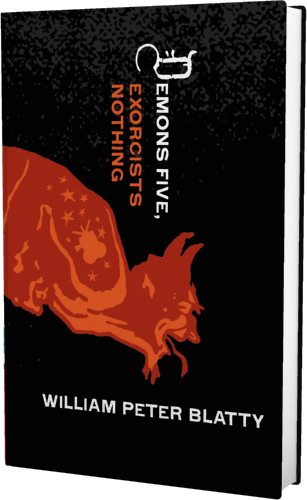
SYNOPSISA scathing modern fable that chronicles the descent of an acclaimed auteur and a Hollywood screenwriter caught in his own private hell. This novel draws on Blatty’s own experiences in Hollywood during the writing and filming of such acclaimed movies as The Exorcist. Blatty takes no prisoners in this fable of towering ambition, cross and doublecross.
Demons Five, Exorcists Nothing is here published with the preferred text by Blatty, incorporating dozens of revisions and amendments. Jacob McMurray designed the dustjacket.
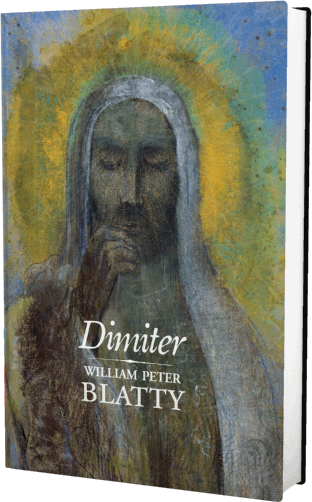
SYNOPSIS
William Peter Blatty has thrilled generations of readers with his iconic international bestsellerThe Exorcist.Now Blatty gives usDimiter, a riveting story of murder, revenge, and suspense. Laced with themes of faith and love, sin and forgiveness, vengeance and compassion, it is a novel in the grand tradition of Morris West’sThe Devil’s Advocate, and the Catholic novels of Graham Greene.
Dimiter opens in the world’s most oppressive and isolated totalitarian state: Albania in the 1970s. A prisoner suspected of being an enemy agent is held by state security. An unsettling presence, he maintains an eerie silence though subjected to unimaginable torture. He escapes, and, on the way to freedom, completes a mysterious mission. The prisoner is Dimiter, the American agent from hell. The scene shifts to Jerusalem, focusing on Hadassah Hospital and a cast of unusual characters. All become enmeshed in a series of baffling, inexplicable deaths, until events explode in a surprising climax.
Told with unrelenting pace, Dimiter’s compelling, page-turning narrative is haunted by the search for faith and the truths of the human condition.
William Peter Blatty, the writer of numerous novels and screenplays, is best known for his internationally bestselling novel The Exorcist, deemed by the New York Times Book Reviewto be as superior to most books of its kind as an Einstein equation is to an accountant’s column of figures. An Academy Award winner for his screenplay for The Exorcist, Blatty is not only the author of one of the most terrifying novels ever written, but, paradoxically, also co-wrote the screenplay for the hilarious Inspector Clouseau film, A Shot in the Dark. New York Times reviewers of his early comic novels noted, Nobody can write funnier lines than William Peter Blatty, describing him as a gifted virtuoso who writes like S. J. Perelman. Blatty lives with his wife and a son in Maryland.
Published on July 16, 2013 12:08
July 15, 2013
NEW PWA WEBSITE
PWA Update from Robert J. Randisi YES, IT'S FINALLY HAPPENED. PWA has a website. We've been dragged kicking and screaming into the 21st century thanks to member and web guru Kevin Burton Smith. It's still under construction, but it already rocks. Take a look here http://www.privateeyewriters.com/ and make sure you read the news portion about the PWA banquet! If you're a PWA member you'll get an invitation. If you're not, then email me at RRandisi@aol.com for information. RJR
Published on July 15, 2013 17:46
Crime Square; Joel Goldman
[image error]
CRIME SQUARE IS OUT--again.
Originally published last year by Vantage Books, edited by Bob Randisi, that company quickly went belly up, leaving the book an orphan. My thanks to John Boland at PERFECT CRIME BOOKS for picking the book up and bringing it out anew. The stories in the book describe Times Square throughout its history, and are by the best in the business. Max Collins, John Lutz, Reed Farrel Coleman, Christine Matthews, Brad Parks, Gary Phillips, Parnell Hall and more. It's available know as a Trade Paperback and an ebook.
--Bob Randisi
-----------------------------------
GREAT INTERVIEW WITH BESTSELLING CRIME WRITER JOEL GOLDMAN
http://www.npr.org/2013/07/15/201177814/g-man-f
ights-crime-and-a-medical-disorder-in-kansas-city
Published on July 15, 2013 05:56
Ed Gorman's Blog
- Ed Gorman's profile
- 118 followers
Ed Gorman isn't a Goodreads Author
(yet),
but they
do have a blog,
so here are some recent posts imported from
their feed.



